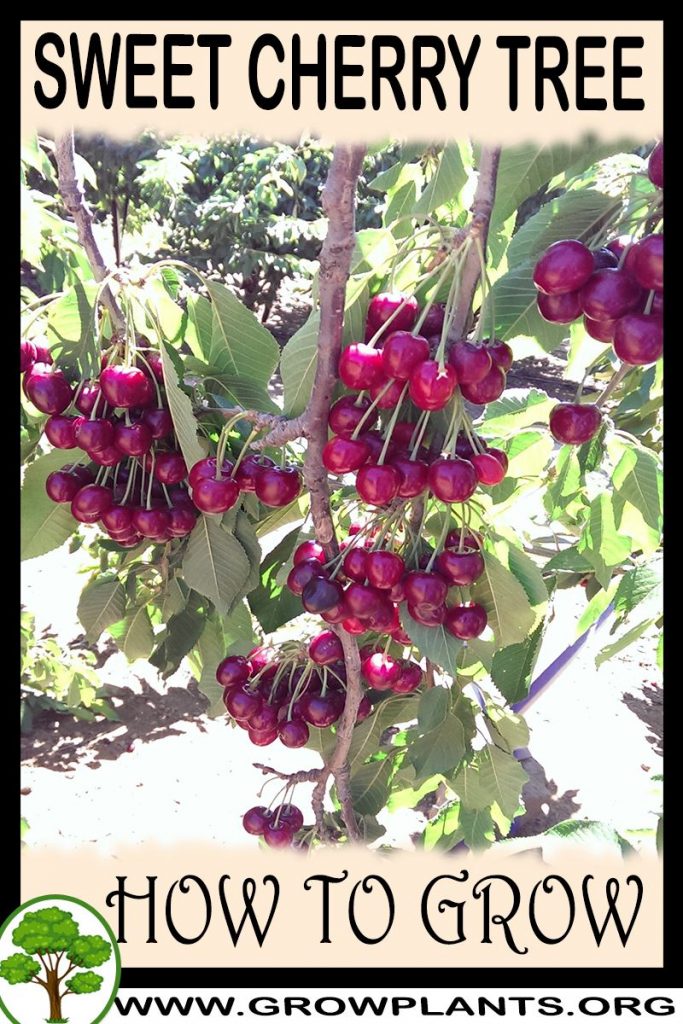Sweet cherry tree grow and care – tree of the genus Prunus also known as Sweet cherry, Sweet cherry tree perennial deciduous plant, grow in temperate climate and some species can grow in cold mediterranean or subtropical climate and grow in hardiness zone 5-10a.
Flower color white or pink with five petals.
Sweet cherry tree fruits
Fruit shape round, size 1-3+ cm, color of the fruit can be: red orange, black, purple, pink yellow, fruits mostly grow in pair but can be more
Sweet cherry tree for sale – Seeds or Plants to Buy
How to grow Sweet cherry tree growing and care:
Chilling hours, if the tree attack in the beginning of the winter need to collect all the leaves and the fruit from the ground, cut all the infected branches
What is the best way to start growing?
Plant
Is it necessary to graft reproduction in Sweet cherry tree?
Yes
Difficulties or problems when growing:
Very sensitive to pests and disease
Planting season:
Winter, spring, summer
Pests and diseases:
Aphids, Borer, mite
Pruning season:
Winter
How to prune:
Weak, dead and thin branches
Size of the plant?
4-10 m, 12-30 feet
Growth speed in optimal condition:
Medium growing
Water requirement:
Average amount of water / Big amount of water
Light conditions in optimal condition for growing:
Full Sun
Is it possible to grow indoor as houseplant?
No
Growing is also possible in a planter /flowerpot / containers:
No
Blooming information
Bloom season:
Spring
General information about the flower
White or pink flowers five petals
Thinning the bloom:
Firsts years recommend thinning
Pollination is done by:
Bees
Edible fruits
Fruit harvest season:
Spring / Summer
Fruits pests or diseases:
Birds, fruit fly (cherry, mediterranean and more)
What can be done with big quantities of Sweet cherry tree fruits?
Eaten raw, jams, juice, alcohol, cakes
Work requirements on the fruit:
Cover the trees with net or protect the fruit with traps
How long does it take to bear fruit?
3-6 years
Scientific name:
Prunus avium
Categories
| Blooming Seasons |
|
|---|---|
| Edible Parts |
|
| Culinary uses |
|
| Flower colors |
|
| Climate |
|
| Harvest Season |
|
| Plant growing speed |
|
| Plant life-form |
|
| Plant Uses |
|
| Planting Season |
|
| Plants sun exposure |
|
| Watering plants |
|
| Hardiness zone |
|
How to grow Sweet cherry tree growing and care:
Chilling hours, if the tree attack in the beginning of the winter need to collect all the leaves and the fruit from the ground, cut all the infected branches
What is the best way to start growing?
Plant
Is it necessary to graft reproduction in Sweet cherry tree?
Yes
Difficulties or problems when growing:
Very sensitive to pests and disease
Planting season:
Winter, spring, summer
Pests and diseases:
Aphids, Borer, mite
Pruning season:
Winter
How to prune:
Weak, dead and thin branches
Size of the plant?
4-10 m, 12-30 feet
Growth speed in optimal condition:
Medium growing
Water requirement:
Average amount of water / Big amount of water
Light conditions in optimal condition for growing:
Full Sun
Is it possible to grow indoor as houseplant?
No
Growing is also possible in a planter /flowerpot / containers:
No
Blooming information
Bloom season:
Spring
General information about the flower
White or pink flowers five petals
Thinning the bloom:
Firsts years recommend thinning
Pollination is done by:
Bees
Edible fruits
Fruit harvest season:
Spring / Summer
Fruits pests or diseases:
Birds, fruit fly (cherry, mediterranean and more)
What can be done with big quantities of Sweet cherry tree fruits?
Eaten raw, jams, juice, alcohol, cakes
Work requirements on the fruit:
Cover the trees with net or protect the fruit with traps
How long does it take to bear fruit?
3-6 years
Scientific name:
Prunus avium

